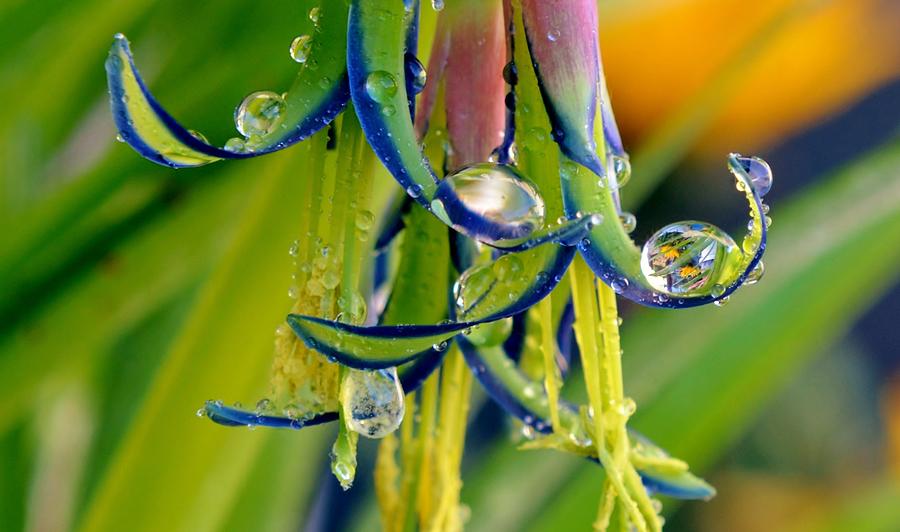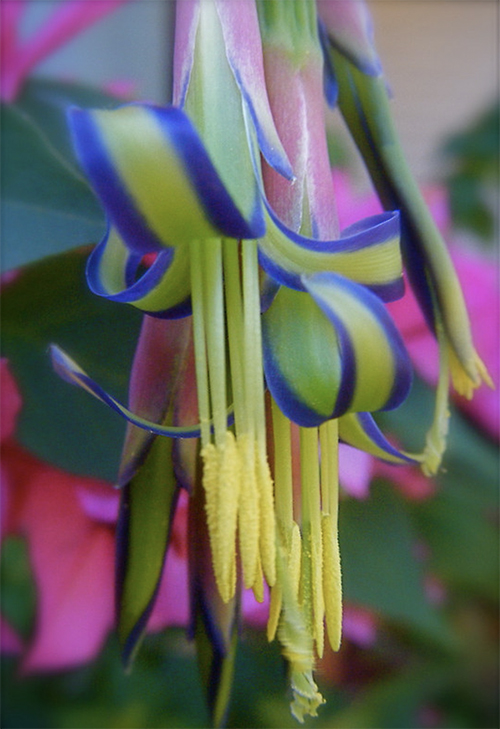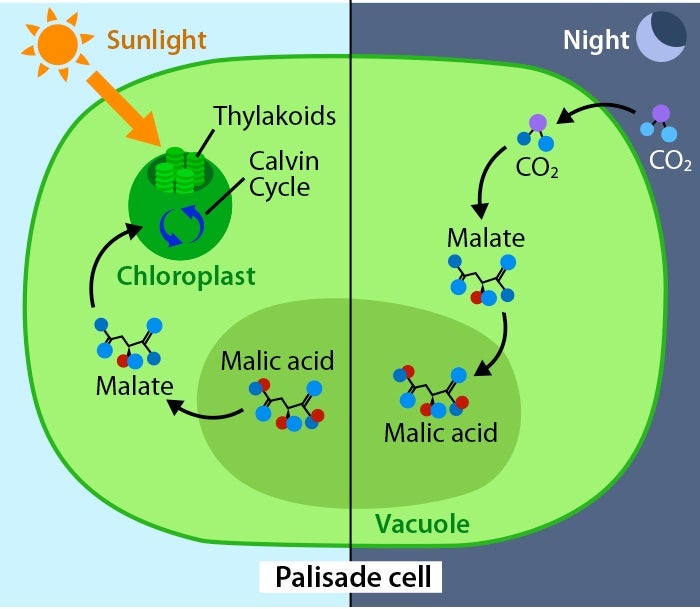Botanical Name: Billbergia nutans

Billbergia nutans [1]
Common Names:
‘Queens Tears‘ and the ‘Friendship Plant‘
Family: Bromeliadaceae
Origin: This epiphytic plant is native to Brazil, Paraguay, Uruguay, and Argentina. The plant in its native South American environment typically grows as both an epiphyte in low trees as well as terrestrially on the forest floor. The plant, in its natural habitat, grows anywhere from 2,300 to 3,000 feet above sea level.
General Physiology:
Leaves: This plant is considered to be succulent [3], by which its leaves are thicker and more fleshy in nature. The purpose of this adaptation is for water and nutrient retention in order for the plant to thrive in arid environments. The edges of the leaves are aligned with small toothed spikes, which aid in protection from external stressors.
Young plants grow upright into rosettes. As the plant matures and the leaves age, the leaves arch outward, eventually drooping downwards. Typically each plant only has 5 to 8 narrow stiff sword-shaped leaves arranged in a tubular rosette of which the upper half flares outward. (Because the plant flares outward, the plant should be afforded plenty of room to grow). The leaves grow to about 10-14″ long and 0.5″ wide. The leaves are typically olive-green colored, however they may assume a reddish hue if grown in full sunlight.

Artists rendering of Billbergia nutans [5], notice the toothed leaf edges
The 1″ long pendant flowers are pink with royal blue edged petals that are backed by 2-3″ long pink bracts.
(To watch a time-laps video of the Billbergia nutans flower, click here: http://botanicaladventures.tumblr.com/post/136825015249/okay-so-there-are-a-lot-of-problems-regarding-this)
Roots: This species of plant, much like other epiphytes, does not have a dominant root system. Rather the root system in this species is very primitive, in which it is predominantly used as an anchor system to hold the plant tight to whatever platform the plant has sprouted from.
Nutrient Acquisition:

Billbergia nutans image depicting water droplets on flower petals [2]
Photosynthesis
This species of Billbergia photosynthesize through the CAM process in which they close their stomatal pores during the day in order to prevent water loss and open
them at night to fix carbon dioxide and release oxygen. By closing their pores during the day, they are allowed to regulate water uptake and loss. As you can see at night, the plant absorbs CO2 and converts it to a 4-Carbon molecule which is then stored as Malic Acid in the plants lumen. During the day time, when the stomata are closed, the plants conducts the Calvin Cycle in producing its sugar molecules (Starch). With the coming of darkness, then the cycle repeats itself, releasing oxygen through the stomatal pores and taking in carbon dioxide fur further photosynthesis. [6]Reproduction:
The Billbergia nutans is considered a monocot flowering plant; by which it produces a seed with only one leaf or cotyledon. This species of Bromeliad can reproduce in two ways; through sexual reproduction in which the seed is fertilized by a pollen grain naturally or via propagation of the seed; or by the separation and relocation of a pup to a new location.

Billbergia nutans, showing protruding stamen with pollen sacs [8]
This species of Bromeliad contains sepal nectares, by which the nectar is found on the sepal petals. The plant also has inferior ovaries, in which the petals and sepals are located above the ovary.
Or as the second common name implies the “friendship plant”, you can remove a pup from the clump and repot the pup into its own pot.
History:
The plant is named after a Swedish lawyer named Gustaf Johan Billberg (1772-1844). Billberg was a lawyer by profession, but also a self-trained botanist, zoologist, and anatomist who authored the book Flora of Sweden. [3]
The name ‘Queen’s Tears’ refers to how when flowering, the flowers droop towards the ground while being highlighted with a royal blue hue that often exude tear-like droplets of nectar when touched or disturbed. The other common name used for this plant is the ‘Friendship plant’, the plant received this nickname for how the plant multiplies readily and is easily propagated thus making it a plant that is easily ‘shared amongst friends’. [3]
Home Care:
This plant is considered to be one of the easiest plants to grow at home. Given adequate warmth, the plant should continue to grow. The plant grows best between 45-81 °F. The plant should be given bright light with at least 3-4 hours of direct sunlight daily to promote good leaf color (olive-green with slight reddish hue) as well as to help promote regular flowering. The plant does best when grown under moderate humidity, but it is recommended that the plant continue to receive an occasional misting to ensure plentiful moisture. What makes this bromeliad different from the Tillandsia species is this plant thrives with water sitting within the central-rosette; experts recommend replacing the stagnant water once monthly by tipping the plant upside down and pouring out the sitting water. [4]
Works Cited:
[1] https://www.monticelloshop.org/692937.html
[2] https://fineartamerica.com/featured/17-billbergia-nutans-queens-tears-werner-lehmann.html
[3] https://www.smgrowers.com/products/plants/plantdisplay.asp?plant_id=254
[4] http://www.plantsrescue.com/tag/billbergia-nutans-var-nutans/
Time-lapse flowering video: http://botanicaladventures.tumblr.com/post/136825015249/okay-so-there-are-a-lot-of-problems-regarding-this
[5] https://www.gettyimages.com/detail/illustration/illustration-of-billbergia-nutans-a-royalty-free-illustration/98955189
[6] Borland, A. M., Hartwell, J., Weston, D. J., Schlauch, K. A., Tschaplinski, T. J., Tuskan, G. A., . . . Cushman, J. C. (2014). Engineering crassulacean acid metabolism to improve water-use efficiency. Trends in Plant Science, 19(5), 327-338. 10.1016/j.tplants.2014.01.006 Retrieved from http://www.ncbi.nlm.nih.gov/pubmed/24559590
[7] http://www.cell.com/trends/plant-science/fulltext/S1360-1385(14)00021-1
[8] https://www.dayliliesinaustralia.com.au/queens-tears-plant-billbergia-nutans/
This page was created by Joseph Talarico

